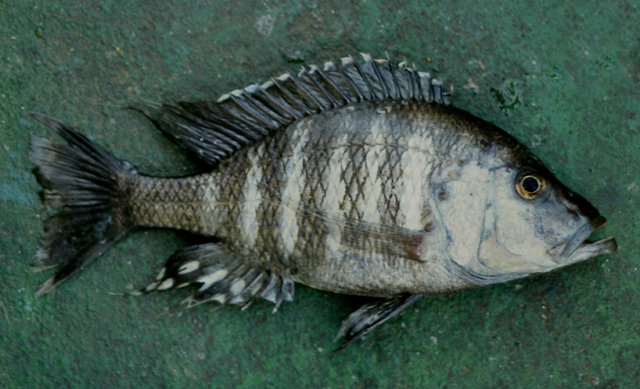| Cichlidae (Cichlids), subfamily: Pseudocrenilabrinae |
| 20.1 cm SL (male/unsexed) |
|
benthopelagic; freshwater; depth range 18 - 150 m |
| Africa: Endemic to southern part of Lake Malawi. |
|
Dorsal spines (total): 15-17; Dorsal soft rays (total): 9-11; Anal spines: 3-3; Anal soft rays: 8-10. Diagnosis: no protuberance on the chest (Ref. 55908). Low number of gill-rakers (Ref. 27611, 55908). Pores and bones in infraorbital series on the head small; lower jaw 44.7-51.1% head length; 3-4 rows of scales on cheek starting from ventroposterior corner (Ref. 55908).
Description: body shape variable, from relatively elongate to deep-bodied; lower jaw clearly prognathous; sensory canal openings moderately enlarged, somewhat atypical for the genus; no large reduction in scales on the cheek, with major part of the cheek scaled; outer teeth in adults unicuspid, sharp and slightly recurved, and inner teeth unicuspid; lower pharyngeal bone stout and relatively broad, but not really enlarged, with stout, big and widely set teeth; gill-rakers relatively stout and simple except for the largest ones, which may be claviform and polyfid; 23-32 scales in upper part of lateral line, 14-20 in lower part (Ref. 55908).
Coloration: Live: Adult (territorial) males: black with a purple hue on dorsal part of body and a blue-green hue laterally on head; unpaired fins dark grey; dorsal fin with white margin; vague dark maculae and striae pattern on dorsal and caudal fins; anal fin dark proximally, lighter grey distally with large yellow-white ocelli; pectoral fins transparent; pelvic fins black with white leading edge (Ref. 55908). Females: silvery with a purple hue on dorsal and dorso-lateral parts of body and head; fins grey or yellow-grey; vague dark maculae and striae pattern on dorsal and caudal fins (Ref. 55908). Immature and non-territorial males with color pattern intermediate between females and territorial males, becoming darker with increasing territoriality (Ref. 55908). Preserved: Juveniles, females and non-territorial males: brownish yellow with 6-7 vertical bars below the dorsal fin; ventral part of body silvery in some large females; dorsal and caudal fin greyish-brown, sometimes with some inconspicuous dark maculae; pelvic and anal fins yellow-white; pectorals transparent (Ref. 55908). Territorial males: dark brown with vertical bars; parts between bars lighter brown; branchiostegal membranes, pelvic fins and ventral part of body dark brown to black; pectorals whitish; dorsal, anal and caudal fins grey-black; dorsal fin lappets white; no maculae visible on dorsal and caudal fins (Ref. 55908). |
| More or less evenly distributed below 60m (Ref. 55908). Prefers sandy and muddy bottoms (Ref. 5595). |
|
Least Concern (LC); Date assessed: 22 June 2018 Ref. (130435)
|
| harmless |
Source and more info: www.fishbase.org. For personal, classroom, and other internal use only. Not for publication.

